Long-Term Performance of Magnetic Force Microscopy Tips Grown by Focused Electron Beam Induced Deposition
Abstract
:1. Introduction
2. Materials and Methods
2.1. FEBID Fe-Based Magnetic Tips Fabrication
2.2. MFM Measurements
3. Results
3.1. FEBID-Tips Fabrication
3.2. MFM Results
4. Conclusions and Outlook
Author Contributions
Funding
Institutional Review Board Statement
Informed Consent Statement
Data Availability Statement
Acknowledgments
Conflicts of Interest
References
- Kazakova, O.; Puttock, R.; Barton, C.; Corte-León, H.; Jaafar, M.; Neu, V.; Asenjo, A. Frontiers of magnetic force microscopy. J. Appl. Phys. 2019, 125, 60901. [Google Scholar] [CrossRef]
- Schwarz, A.; Wiesendanger, R. Magnetic sensitive force microscopy. Nano Today 2008, 3, 28–39. [Google Scholar] [CrossRef]
- Feng, Y.; Vaghefi, P.M.; Vranjkovic, S.; Penedo, M.; Kappenberger, P.; Schwenk, J.; Zhao, X.; Mandru, A.-O.; Hug, H. Magnetic force microscopy contrast formation and field sensitivity. J. Magn. Magn. Mater. 2022, 551, 169073. [Google Scholar] [CrossRef]
- Yagil, A.; Almoalem, A.; Soumyanarayanan, A.; Tan, A.K.C.; Raju, M.; Panagopoulos, C.; Auslaender, O.M. Stray field signatures of Néel textured skyrmions in Ir/Fe/Co/Pt multilayer films. Appl. Phys. Lett. 2018, 112, 192403. [Google Scholar] [CrossRef] [Green Version]
- Rawlings, C.; Durkan, C. Performing quantitative MFM measurements on soft magnetic nanostructures. Nanotechnology 2012, 23, 455701. [Google Scholar] [CrossRef]
- Wood, R.; Smith, N. Fields from a Magnetized Conical Shell and Quantitative Magnetic Force Microscopy. IEEE Trans. Magn. 2021, 58, 1–9. [Google Scholar] [CrossRef]
- Vergara, J.; Favieres, C.; Madurga, V. Magnetic domain configurations of pulsed laser deposited MnBi hard magnetic films. J. Magn. Magn. Mater. 2022, 554, 169316. [Google Scholar] [CrossRef]
- Salaheldeen, M.; Vega, V.; Ibabe, A.; Jaafar, M.; Asenjo, A.; Fernandez, A.; Prida, V.M. Tailoring of Perpendicular Magnetic Anisotropy in Dy13Fe87 Thin Films with Hexagonal Antidot Lattice Nanostructure. Nanomaterials 2018, 8, 227. [Google Scholar] [CrossRef] [Green Version]
- Ghidini, M.; Maccherozzi, F.; Dhesi, S.S.; Mathur, N.D. XPEEM and MFM Imaging of Ferroic Materials. Adv. Electron. Mater. 2022, 8, 2200162. [Google Scholar] [CrossRef]
- Heczko, O. Antiphase boundaries in Ni-Mn-Ga ordered compound. AIP Adv. 2020, 10, 15137. [Google Scholar] [CrossRef] [Green Version]
- Ehrmann, A.; Blachowicz, T. Magnetic Force Microscopy on Nanofibers—Limits and Possible Approaches for Randomly Oriented Nanofiber Mats. Magnetochemistry 2021, 7, 143. [Google Scholar] [CrossRef]
- Angeloni, L.; Passeri, D.; Corsetti, S.; Peddis, D.; Mantovani, D.; Rossi, M. Single nanoparticles magnetization curves by controlled tip magnetization magnetic force microscopy. Nanoscale 2017, 9, 18000–18011. [Google Scholar] [CrossRef]
- Stepanova, M.; Masell, J.; Lysne, E.; Schoenherr, P.; Köhler, L.; Paulsen, M.; Qaiumzadeh, A.; Kanazawa, N.; Rosch, A.; Tokura, Y.; et al. Detection of Topological Spin Textures via Nonlinear Magnetic Responses. Nano Lett. 2022, 22, 14–21. [Google Scholar] [CrossRef] [PubMed]
- Arekapudi, S.S.P.K.; Böhm, B.; Ramasubramanian, L.; Ganss, F.; Heinig, P.; Stienen, S.; Fowley, C.; Lenz, K.; Deac, A.M.; Albrecht, M.; et al. Direct imaging of distorted vortex structures and magnetic vortex annihilation processes in ferromagnetic/antiferromagnetic disk structures. Phys. Rev. B 2021, 103, 14405. [Google Scholar] [CrossRef]
- Schwenk, J.; Marioni, M.; Romer, S.; Joshi, N.R.; Hug, H.J. Non-contact bimodal magnetic force microscopy. Appl. Phys. Lett. 2014, 104, 112412. [Google Scholar] [CrossRef] [Green Version]
- Vokoun, D.; Samal, S.; Stachiv, I. Magnetic Force Microscopy in Physics and Biomedical Applications. Magnetochemistry 2022, 8, 42. [Google Scholar] [CrossRef]
- Suzuki, R.; Ishihara, S.; Ohtake, M.; Futamoto, M. Fabrication of Tips for Magnetic Force Microscopy Employing Magnetic Multilayer Structures. Key Eng. Mater. 2014, 605, 465–469. [Google Scholar] [CrossRef]
- Ishihara, S.; Ohtake, M.; Futamoto, M. Switching fields of high-resolution magnetic force microscope tips coated with Co, Co75Pt10Cr15, Co75Pt25, and Co50Pt50films. EPJ Web Conf. 2014, 75, 6007. [Google Scholar] [CrossRef] [Green Version]
- Koblischka, M.; Kirsch, M.; Wei, J.; Sulzbach, T.; Hartmann, U. Preparation of ferrite-coated MFM cantilevers. J. Magn. Magn. Mater. 2007, 316, e666–e669. [Google Scholar] [CrossRef]
- Sungthong, A.; Ruksasakchai, P.; Saengkaew, K.; Cheowanish, I.; Damrongsak, B. Response of Magnetic Force Microscopy Probes under AC Magnetic Field. J. Phys. Conf. Ser. 2017, 901, 12092. [Google Scholar] [CrossRef]
- Akdogan, O.; Akdogan, N.G. SmCo-based MFM probes with high switching fields. J. Magn. Magn. Mater. 2021, 520, 167124. [Google Scholar] [CrossRef]
- Fischer, P.B. Ultrahigh resolution magnetic force microscope tip fabricated using electron beam lithography. J. Vac. Sci. Technol. B Microelectron. Nanometer Struct. 1993, 11, 2570. [Google Scholar] [CrossRef]
- Koblischka, M.; Hartmann, U.; Sulzbach, T. Improvements of the lateral resolution of the MFM technique. Thin Solid Film. 2003, 428, 93–97. [Google Scholar] [CrossRef]
- Phillips, G.N.; Siekman, M.; Abelmann, L.; Lodder, J.C. High resolution magnetic force microscopy using focused ion beam modified tips. Appl. Phys. Lett. 2002, 81, 865–867. [Google Scholar] [CrossRef]
- Gao, L.; Yue, L.; Yokota, T.; Skomski, R.; Liou, S.; Takahoshi, H.; Saito, H.; Ishio, S. Focused Ion Beam Milled CoPt Magnetic Force Microscopy Tips for High Resolution Domain Images. IEEE Trans. Magn. 2004, 40, 2194–2196. [Google Scholar] [CrossRef]
- Kuramochi, H.; Manago, T.; Koltsov, D.; Takenaka, M.; Iitake, M.; Akinaga, H. Advantages of CNT–MFM probes in observation of domain walls of soft magnetic materials. Surf. Sci. 2007, 601, 5289–5293. [Google Scholar] [CrossRef]
- Yoshida, N.; Arie, T.; Akita, S.; Nakayama, Y. Improvement of MFM Tips Using Fe-Alloy-Capped Carbon Nanotubes. Phys. B Condens. Matter 2002, 323, 149–150. [Google Scholar] [CrossRef]
- Iglesias-Freire, O.; Jaafar, M.; Berganza, E.; Asenjo, A. Customized MFM probes with high lateral resolution. Beilstein J. Nanotechnol. 2016, 7, 1068–1074. [Google Scholar] [CrossRef] [Green Version]
- Utke, I.; Hoffmann, P.; Berger, R.; Scandella, L. High-resolution magnetic Co supertips grown by a focused electron beam. Appl. Phys. Lett. 2002, 80, 4792–4794. [Google Scholar] [CrossRef]
- Gavagnin, M.; Wanzenboeck, H.D.; Belic, D.; Shawrav, M.M.; Persson, A.; Gunnarsson, K.; Svedlindh, P.; Bertagnolli, E. Magnetic force microscopy study of shape engineered FEBID iron nanostructures. Phys. Status Solidi A 2013, 211, 368–374. [Google Scholar] [CrossRef]
- Gavagnin, M.; Wanzenboeck, H.D.; Wachter, S.; Shawrav, M.M.; Persson, A.; Gunnarsson, K.; Svedlindh, P.; Stöger-Pollach, M.; Bertagnolli, E. Free-Standing Magnetic Nanopillars for 3D Nanomagnet Logic. ACS Appl. Mater. Interfaces 2014, 6, 20254–20260. [Google Scholar] [CrossRef] [PubMed]
- Huth, M.; Porrati, F.; Dobrovolskiy, O. Focused electron beam induced deposition meets materials science. Microelectron. Eng. 2018, 185–186, 9–28. [Google Scholar] [CrossRef] [Green Version]
- Idigoras, O.; Nikulina, E.; Porro, J.M.; Vavassori, P.; Chuvilin, A.; Berger, A. FEBID fabrication and magnetic characterization of individual nano-scale and micro-scale Co structures. Nanofabrication 2014, 1, 23–34. [Google Scholar] [CrossRef]
- Pérez-Roldán, M.J.; Tatti, F.; Vavassori, P.; Berger, A.; Chuvilin, A. Segregation of materials in double precursor electron-beam-induced-deposition: A route to functional magnetic nanostructures. Nanotechnology 2015, 26, 375302. [Google Scholar] [CrossRef]
- Córdoba, R.; Barcones, B.; Roelfsema, E.; Verheijen, M.A.; Mulders, J.J.L.; Trompenaars, P.H.F.; Koopmans, B. Functional nickel-based deposits synthesized by focused beam induced processing. Nanotechnology 2016, 27, 65303. [Google Scholar] [CrossRef] [PubMed]
- Porrati, F.; Pohlit, M.; Müller, J.; Barth, S.; Biegger, F.; Gspan, C.; Plank, H.; Huth, M. Direct writing of CoFe alloy nanostructures by focused electron beam induced deposition from a heteronuclear precursor. Nanotechnology 2015, 26, 475701. [Google Scholar] [CrossRef] [Green Version]
- Magén, C.; Pablo-Navarro, J.; De Teresa, J. Focused-Electron-Beam Engineering of 3D Magnetic Nanowires. Nanomaterials 2021, 11, 402. [Google Scholar] [CrossRef]
- Preischl, C.; Le, L.H.; Bilgilisoy, E.; Vollnhals, F.; Gölzhäuser, A.; Marbach, H. Controlled Electron-Induced Fabrication of Metallic Nanostructures on 1 nm Thick Membranes. Small 2020, 16, e2003947. [Google Scholar] [CrossRef]
- Skoric, L.; Donnelly, C.; Hierro-Rodriguez, A.; Sandoval, M.A.C.; Ruiz-Gómez, S.; Foerster, M.; Niño, M.A.; Belkhou, R.; Abert, C.; Suess, D.; et al. Domain Wall Automotion in Three-Dimensional Magnetic Helical Interconnectors. ACS Nano 2022, 16, 8860–8868. [Google Scholar] [CrossRef]
- Mattiat, H.; Rossi, N.; Gross, B.; Pablo-Navarro, J.; Magén, C.; Badea, R.; Berezovsky, J.; De Teresa, J.M.; Poggio, M. Nanowire Magnetic Force Sensors Fabricated by Focused-Electron-Beam-Induced Deposition. Phys. Rev. Appl. 2020, 13, 44043. [Google Scholar] [CrossRef] [Green Version]
- Jaafar, M.; Pablo-Navarro, J.; Berganza, E.; Ares, P.; Magén, C.; Masseboeuf, A.; Gatel, C.; Snoeck, E.; Gómez-Herrero, J.; de Teresa, J.M.; et al. Customized MFM probes based on magnetic nanorods. Nanoscale 2020, 12, 10090–10097. [Google Scholar] [CrossRef]
- Pablo-Navarro, J.; Sangiao, S.; Magén, C.; de Teresa, J.M. Magnetic Functionalization of Scanning Probes by Focused Electron Beam Induced Deposition Technology. Magnetochemistry 2021, 7, 140. [Google Scholar] [CrossRef]
- Berganza, E.; Jaafar, M.; Fernandez-Roldan, J.A.; Goiriena-Goikoetxea, M.; Pablo-Navarro, J.; García-Arribas, A.; Guslienko, K.; Magén, C.; De Teresa, J.M.; Chubykalo-Fesenko, O.; et al. Half-hedgehog spin textures in sub-100 nm soft magnetic nanodots. Nanoscale 2020, 12, 18646–18653. [Google Scholar] [CrossRef] [PubMed]
- Stiller, M.; Barzola-Quiquia, J.; Esquinazi, P.D.; Sangiao, S.; De Teresa, J.M.; Meijer, J.; Abel, B. Functionalized Akiyama tips for magnetic force microscopy measurements. Meas. Sci. Technol. 2017, 28, 125401. [Google Scholar] [CrossRef] [Green Version]
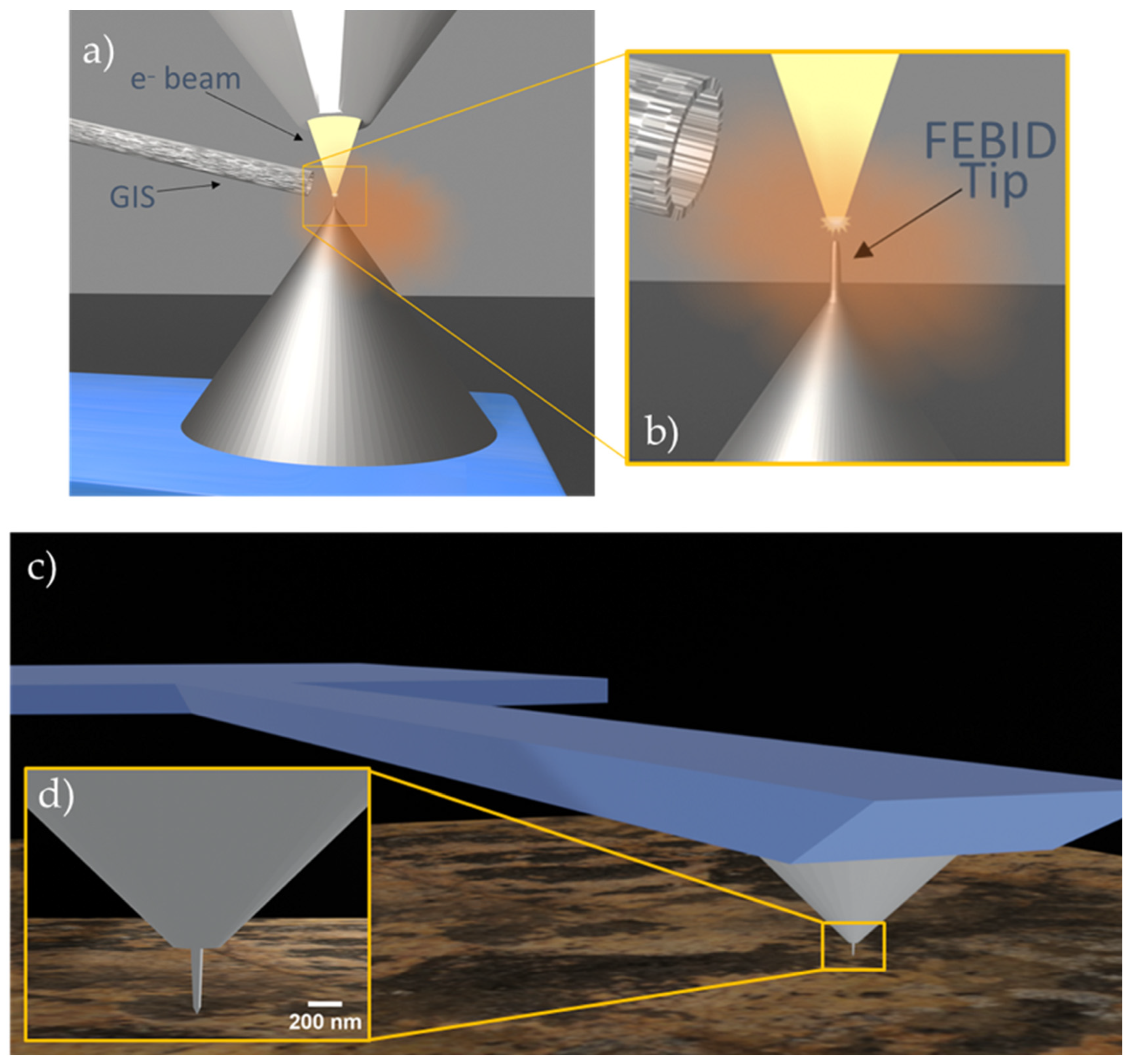
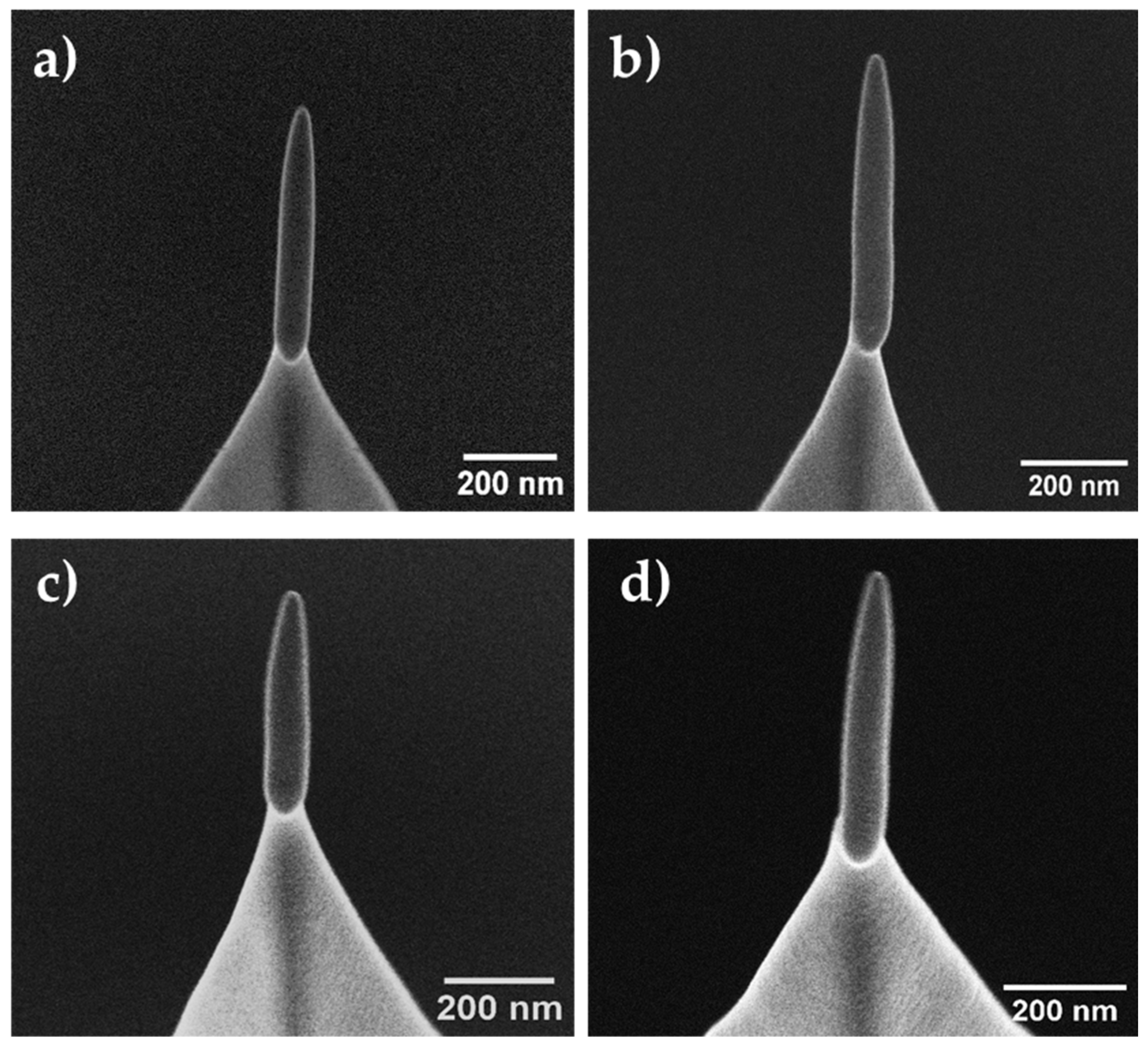
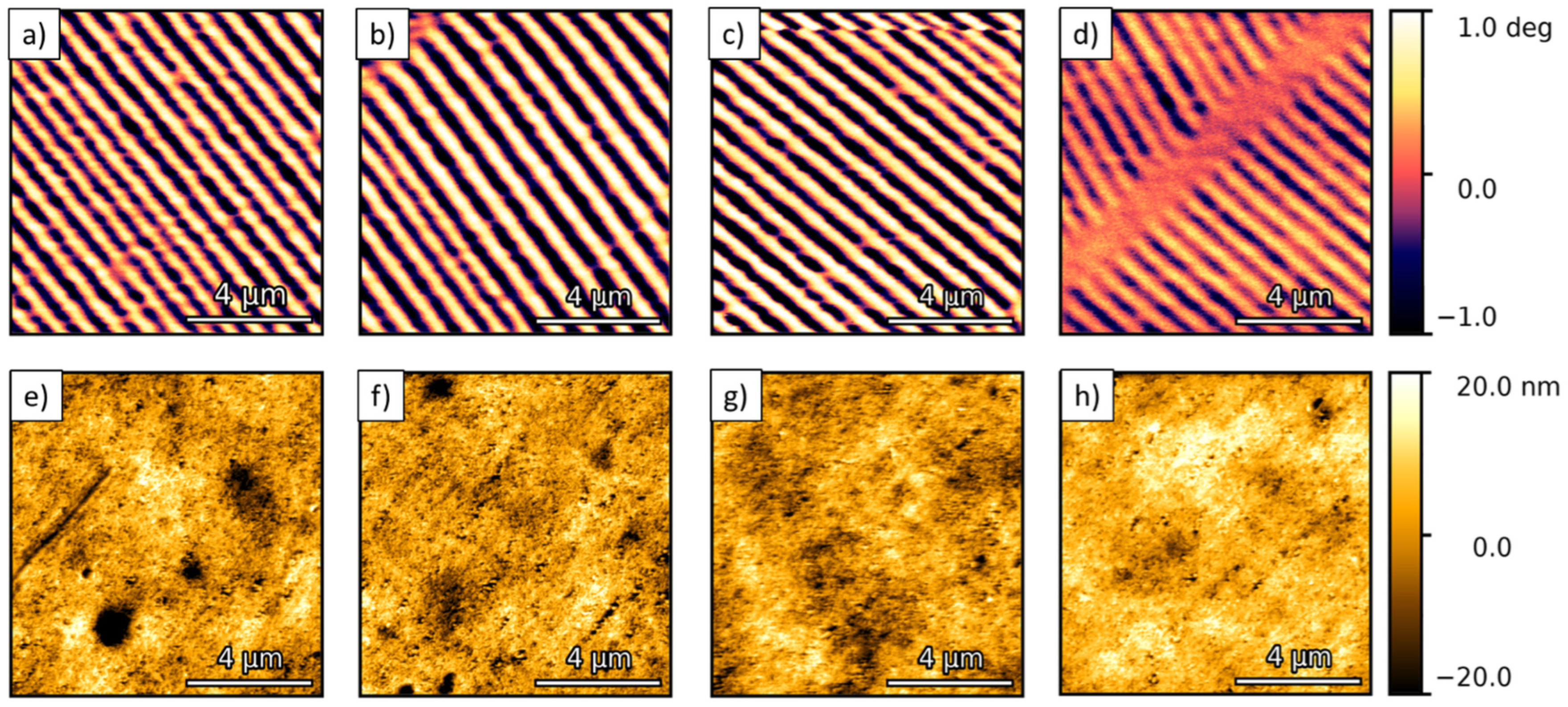
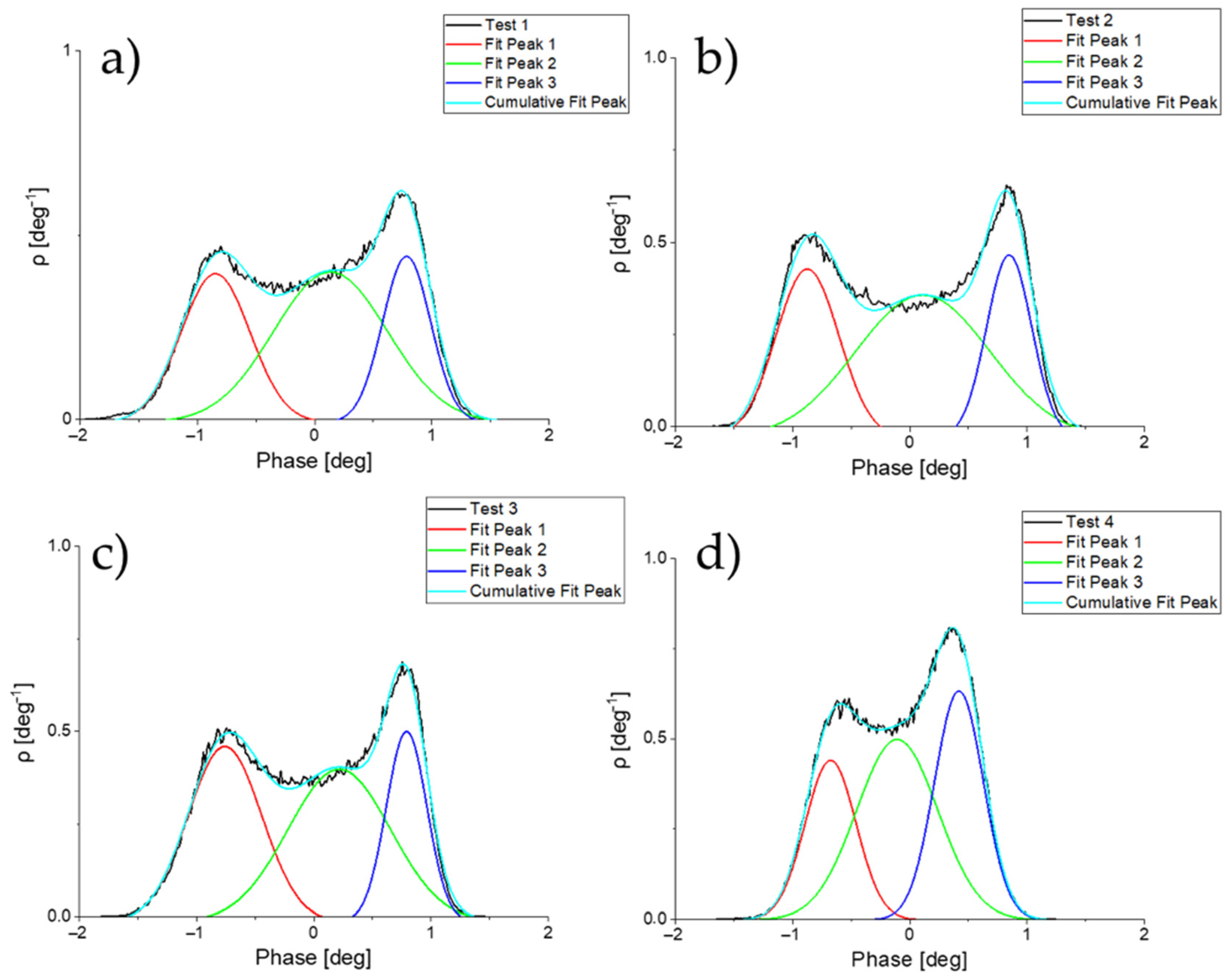
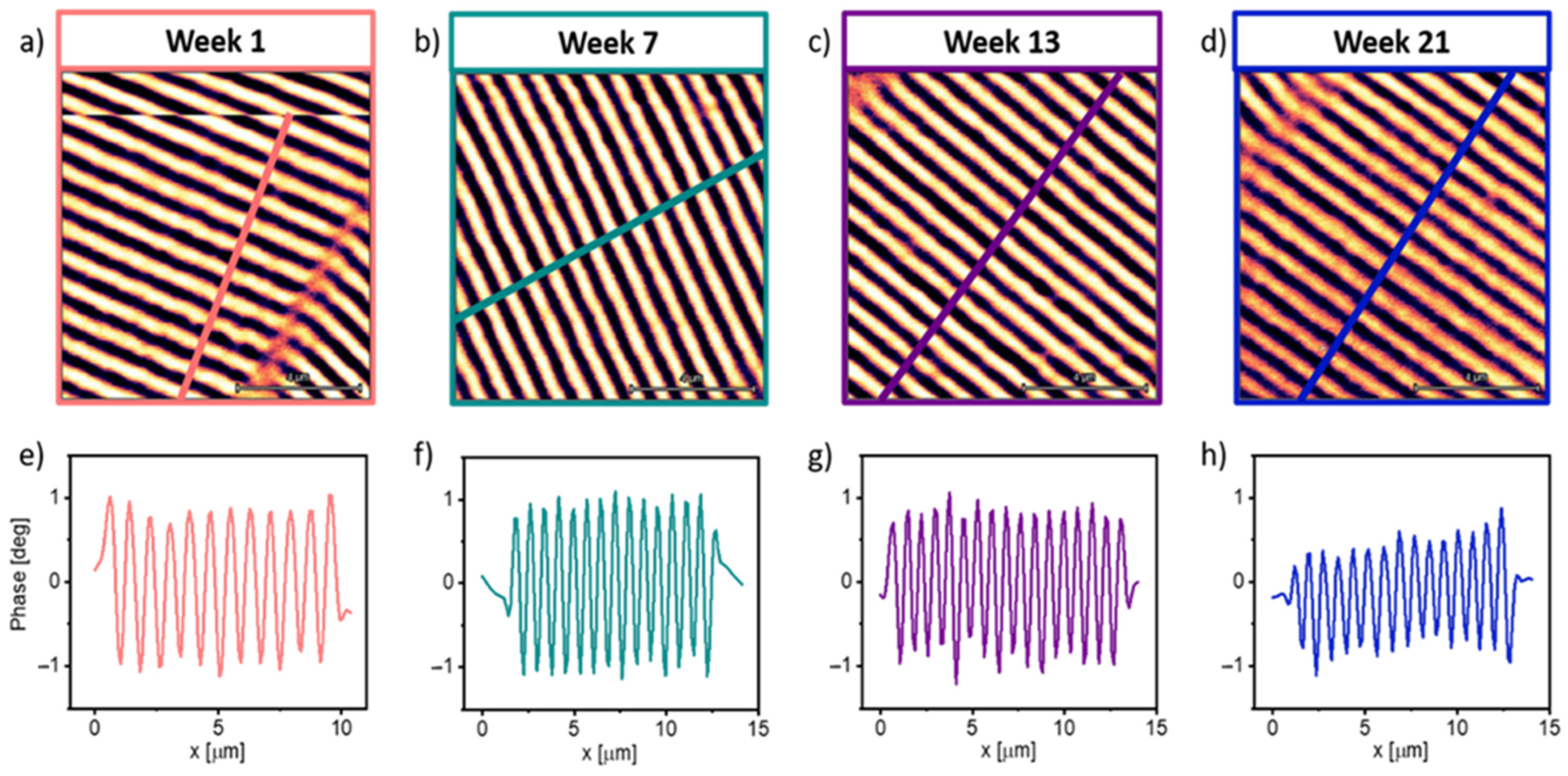
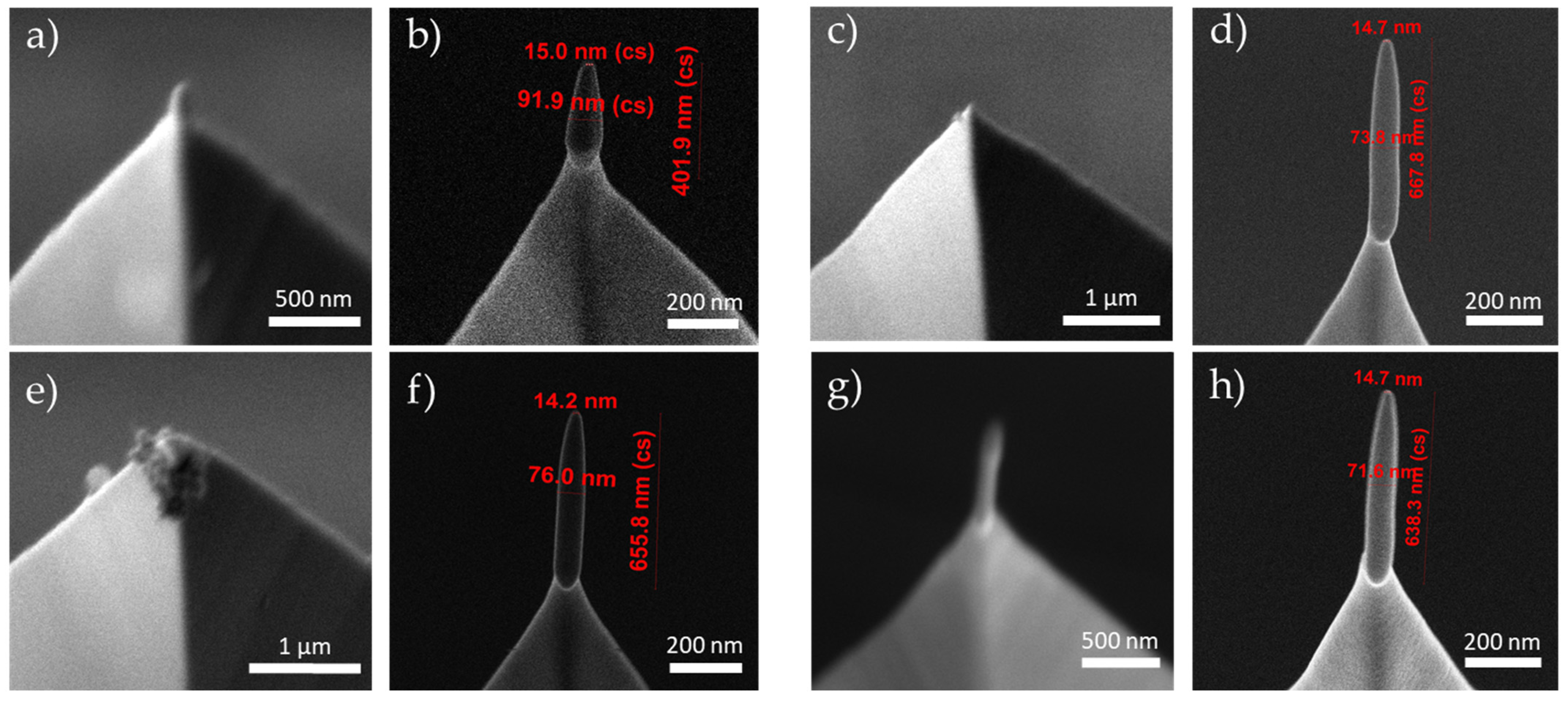
| Tip | ΔP (10−6 mbar) | Deposition Time (s) | Length (nm) | Diameter (nm) | Aspect Ratio |
|---|---|---|---|---|---|
| 1 | 5.4 | 18 | 401.9 | 91.9 | 4.4 |
| 2 | 4.1 | 20 | 354.7 | 76.5 | 4.6 |
| 3 | 4.6 | 28 | 626.6 | 75.0 | 8.4 |
| 4 | 4.3 | 28 | 670.5 | 71.7 | 9.4 |
| 5 | 3.4 | 29 | 655.8 | 76.0 | 8.6 |
| 6 | 4.0 | 29 | 626.1 | 75.4 | 8.3 |
| 7 | 3.4 | 29 | 667.8 | 73.8 | 9.0 |
| 8 | 2.9 | 29 | 550.0 | 75.0 | 7.3 |
| 9 | 2.7 | 31 | 634.5 | 72.8 | 8.7 |
| 10 | 2.3 | 31 | 638.3 | 71.6 | 8.9 |
| Weeks | ||||||||
|---|---|---|---|---|---|---|---|---|
| Tip | 1 | 7 | 13 | 21 | 30 | Comments | ||
| Phase Shift [deg] | N1 | 1 | 0.41 ± 0.02 | 0.38 ± 0.01 | The tip passed all the tests | |||
| PG1 | 2 | 0.28 ± 0.04 | 0.19 ± 0.16 | o | o | MFM signal lost | ||
| 3 | 1.53 ± 0.02 | 1.48 ± 0.02 | o | o | MFM signal lost | |||
| 4 | 1.17 ± 0.01 | 1.52 ± 0.02 | 1.49 ± 0.01 | 0.48 ± 0.01 | The tip passed all the tests | |||
| PG2 | 5 | 1.86 ± 0.03 | 1.31 ± 0.01 | o | o | Tip mechanically damaged | ||
| 6 | 1.81 ± 0.01 | 1.45 ± 0.01 | 1.29 ± 0.01 | 1.27 ± 0.03 | The tip passed all the tests | |||
| 7 | 2.44 ± 0.03 | 1.39 ± 0.02 | o | o | MFM signal lost | |||
| PG3 | 8 | o | o | o | o | Tip mechanically damaged | ||
| 9 | 1.48 ± 0.01 | 1.46 ± 0.01 | 1.31 ± 0.01 | o | Tip mechanically damaged | |||
| 10 | 1.63 ± 0.01 | 1.72 ± 0.01 | 1.55 ± 0.01 | 1.09 ± 0.02 | The tip passed all the tests | |||
Disclaimer/Publisher’s Note: The statements, opinions and data contained in all publications are solely those of the individual author(s) and contributor(s) and not of MDPI and/or the editor(s). MDPI and/or the editor(s) disclaim responsibility for any injury to people or property resulting from any ideas, methods, instructions or products referred to in the content. |
© 2023 by the authors. Licensee MDPI, Basel, Switzerland. This article is an open access article distributed under the terms and conditions of the Creative Commons Attribution (CC BY) license (https://creativecommons.org/licenses/by/4.0/).
Share and Cite
Escalante-Quiceno, A.T.; Novotný, O.; Neuman, J.; Magén, C.; De Teresa, J.M. Long-Term Performance of Magnetic Force Microscopy Tips Grown by Focused Electron Beam Induced Deposition. Sensors 2023, 23, 2879. https://doi.org/10.3390/s23062879
Escalante-Quiceno AT, Novotný O, Neuman J, Magén C, De Teresa JM. Long-Term Performance of Magnetic Force Microscopy Tips Grown by Focused Electron Beam Induced Deposition. Sensors. 2023; 23(6):2879. https://doi.org/10.3390/s23062879
Chicago/Turabian StyleEscalante-Quiceno, Alix Tatiana, Ondřej Novotný, Jan Neuman, César Magén, and José María De Teresa. 2023. "Long-Term Performance of Magnetic Force Microscopy Tips Grown by Focused Electron Beam Induced Deposition" Sensors 23, no. 6: 2879. https://doi.org/10.3390/s23062879





